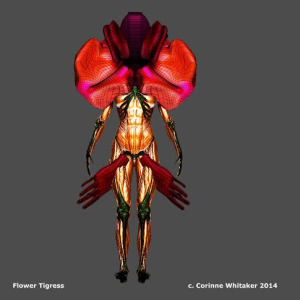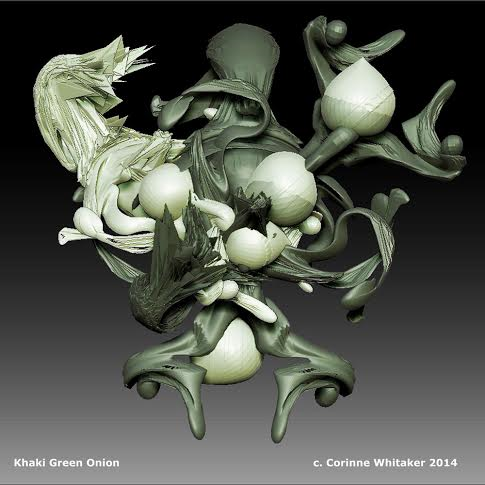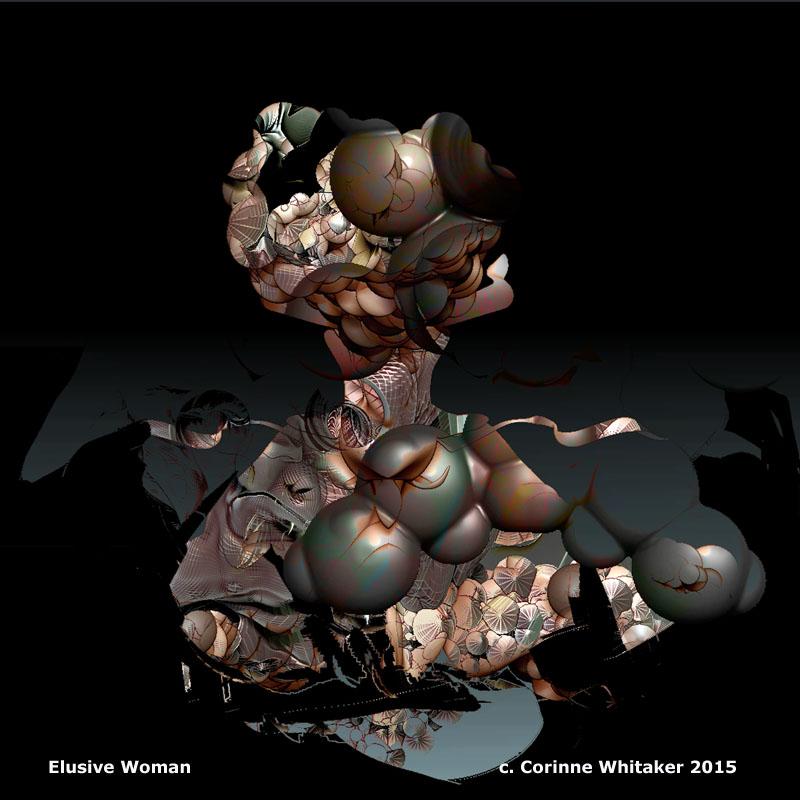 It is already quite uncommon to come across a digital 3D artist who has been working in that medium for decades. And it is even more uncommon to find a woman using digital imaging for that many years. Artist Corinne Whitaker is ahead of her time in more than one way. She has been using digital imaging technologies to produce her works for 35 years, and her website, Digital Giraffe, boasts 22 years of monthly web publication. A pioneer of the technological arts future, her compelling work, some of which is 3D printed, comments on the post-human condition with an eye toward women’s bodies and more optimistic and playful elements in a cultural atmosphere that favors sinister dystopian and post-apocalyptic themes.
It is already quite uncommon to come across a digital 3D artist who has been working in that medium for decades. And it is even more uncommon to find a woman using digital imaging for that many years. Artist Corinne Whitaker is ahead of her time in more than one way. She has been using digital imaging technologies to produce her works for 35 years, and her website, Digital Giraffe, boasts 22 years of monthly web publication. A pioneer of the technological arts future, her compelling work, some of which is 3D printed, comments on the post-human condition with an eye toward women’s bodies and more optimistic and playful elements in a cultural atmosphere that favors sinister dystopian and post-apocalyptic themes.
Whitaker has worked with Shapeways for years; she praises the company’s professionalism and customer service. Shapeways recently interviewed Whitaker about her decades-long career in digital design, and 3DPrint.com followed up with some more questions to round out an understanding of where Whitaker has been, and where the future of digital design and her own career is headed.
Based in Foster City, California, which is the “Heart of Silicon Valley,” Whitaker started working with computers in 1981. She described to Shapeways how her digital modeling experience originated by her own experimentation, since there were no art programs where she could learn these things:
“Initially there were almost no art programs, let alone 3D, so I began by entering irrational equations into science programs to see what would happen. I love accidents, and I still work that way. At the start, desktop computers had neither parallel processing nor multi-tasking, so creating in 3D was more than challenging. (ie, 48 hours of down time, ending in a frozen screen and no image!). Eventually I worked with a Canadian company (Alias Sketch) whose software offered organic possibilities combined with excellent customer support; unfortunately they were bought out and discontinued.”
With her technological expertise firmly established, her decades-long explorations of the human condition led her to the conclusion that the “human species is due to expire, either by self-destruction, exhaustion of natural resources, or cosmic intervention.” Beyond the generalized human condition, Whitaker also has strong views about her time spent in a male-dominated art scene. She told 3DPrint.com that she recently e-mailed a prominent company whose software she uses. She told them that all of their materials — conferences, tutorials, and online work products– feature men, when plenty of women use the products too. She hasn’t heard back from them.
“Part of the problem is one of language and culture: before 3D printing and even now, most fabricators were male engineers. Their language of understanding is somewhat different from that of women. In my own experience, men tend to think in geometric terms, angled and edged, whereas I am drawn to organic forms. The result is that before I can work with fabricators we have to establish a common language of understanding so that we work as a team and not in opposition. Somehow I have to get them to “see” what I am seeing so that the product will reflect my vision rather than theirs.”
 But the male-dominated worlds of art and technology haven’t stopped Whitaker’s unique vision from being realized: it usually just gives women a need to work harder. I have described her post-human designs as “playful,” and she concurs. But there is also some very serious commentary lurking there as well. For this reason it is appropriate to think of her as a “digital Louise Bourgeois“– referencing the great French female sculptor of the 20th century. But there’s also room here to make comparisons to the Mexican painter Remedios Varo, who blends organic and scientific/technological forms in her highly gendered and intensely surrealistic body of painted work. Whitaker explains that her aesthetic qualities are largely due to two factors. She is drawn to organic images, and she has been on a quest to highlight the rare and unseen that lie beneath the surface:
But the male-dominated worlds of art and technology haven’t stopped Whitaker’s unique vision from being realized: it usually just gives women a need to work harder. I have described her post-human designs as “playful,” and she concurs. But there is also some very serious commentary lurking there as well. For this reason it is appropriate to think of her as a “digital Louise Bourgeois“– referencing the great French female sculptor of the 20th century. But there’s also room here to make comparisons to the Mexican painter Remedios Varo, who blends organic and scientific/technological forms in her highly gendered and intensely surrealistic body of painted work. Whitaker explains that her aesthetic qualities are largely due to two factors. She is drawn to organic images, and she has been on a quest to highlight the rare and unseen that lie beneath the surface:
“In the early days of desktop computer imaging I used to defy the rules of mathematical equations to search for the unusual and the rarely seen. The playful quality possibly arises from my optimistic view of that precious gift we call life, in spite of some rather negative observations of what humans have done to their planet and to each other…my images choose me: I have to step out of the way and let them emerge. We go on a voyage, my pieces and I, and if we are successful we awaken feelings and thoughts in others so that they can delve into their own imaginations. Together my images, my viewers and I inhabit a shared mindscape that enhances our understanding of what it means to be alive at this time, in this place.”
 Regarding technology’s challenges, she told Shapeways that software remains the biggest difficulty when creating 3D sculptures due to its steep learning curve, the difficulty translating 2D to 3D design, and the fact that every 3D program has its own vocabulary. But given her conviction that eventually 3D software will be “done away with entirely,” she presents a scenario whereby the most open flexible learners tend to be the most creative artists:
Regarding technology’s challenges, she told Shapeways that software remains the biggest difficulty when creating 3D sculptures due to its steep learning curve, the difficulty translating 2D to 3D design, and the fact that every 3D program has its own vocabulary. But given her conviction that eventually 3D software will be “done away with entirely,” she presents a scenario whereby the most open flexible learners tend to be the most creative artists:
“My thought process is one of letting go and traveling through ideas. It involves the challenge of putting your ego aside and letting yourself go crazy to some degree. As artists we have the luxury of knowing that although we share the wild territory of the insane, we have a round-trip ticket back to what is commonly called sanity. I like to say that we are willing to touch the thorn barehanded in order to know the rose.”
While 3D design inspires deep philosophical musings in one of its founding artists, the public has yet to catch on to its power. But that is changing. Of course, Whitaker credits 3D design and printing technologies with facilitating her own artistic vision, and she predicts that it will become an acceptable artistic medium in the next few decades:
“3D printing allows me to bring to life the swirl of designs that populate my visual realm. As an industry it will definitely revolutionize many fields of endeavor…It took photography 150 years to become accepted as an art form. With the rapid pace of events today I suspect that digital art will become accepted in shorter time, perhaps 20 or 30 years. Possibly its increasing use by Hollywood and the advertising industry is intensifying the pace.”
 In the meantime, Whitaker does not appear to be waiting around for mainstream acceptance of her chosen artistic medium. And she cites a community of artists she gains inspiration from, including Ruth Waters, Derrick Woodham, and Mary Visser. Whitaker’s creatures can be found on her website, in exhibits, and even in a book series, If We Are Erased, which is carried on Amazon. Also a writer and painter, you can check out her incredible work here, while appreciating cutting edge art done by a veteran of digital imaging who still manages to reside and make art in Silicon Valley, USA’s technological otherworld. Discuss this story in the Corrine Whitaker forum thread on 3DPB.com.
In the meantime, Whitaker does not appear to be waiting around for mainstream acceptance of her chosen artistic medium. And she cites a community of artists she gains inspiration from, including Ruth Waters, Derrick Woodham, and Mary Visser. Whitaker’s creatures can be found on her website, in exhibits, and even in a book series, If We Are Erased, which is carried on Amazon. Also a writer and painter, you can check out her incredible work here, while appreciating cutting edge art done by a veteran of digital imaging who still manages to reside and make art in Silicon Valley, USA’s technological otherworld. Discuss this story in the Corrine Whitaker forum thread on 3DPB.com.
Subscribe to Our Email Newsletter
Stay up-to-date on all the latest news from the 3D printing industry and receive information and offers from third party vendors.
You May Also Like
3D Printing Unpeeled: New Arkema Material for HP, Saddle and Macro MEMS
A new Arkema material for MJF is said to reduce costs per part by up to 25% and have an 85% reusability ratio. HP 3D HR PA 12 S has been...
3D Printing News Briefs, January 20, 2024: FDM, LPBF, Underwater 3D Printer, Racing, & More
We’re starting off with a process certification in today’s 3D Printing News Briefs, and then moving on to research about solute trapping, laser powder bed fusion, and then moving on...
3D Printing Webinar and Event Roundup: December 3, 2023
We’ve got plenty of events and webinars coming up for you this week! Quickparts is having a Manufacturing Roadshow, America Makes is holding a Member Town Hall, Stratafest makes two...
Formnext 2023 Day Three: Slam Dunk
I’m high—high on trade show. I’ve met numerous new faces and reconnected with old friends, creating an absolutely wonderful atmosphere. The excitement is palpable over several emerging developments. The high...
































